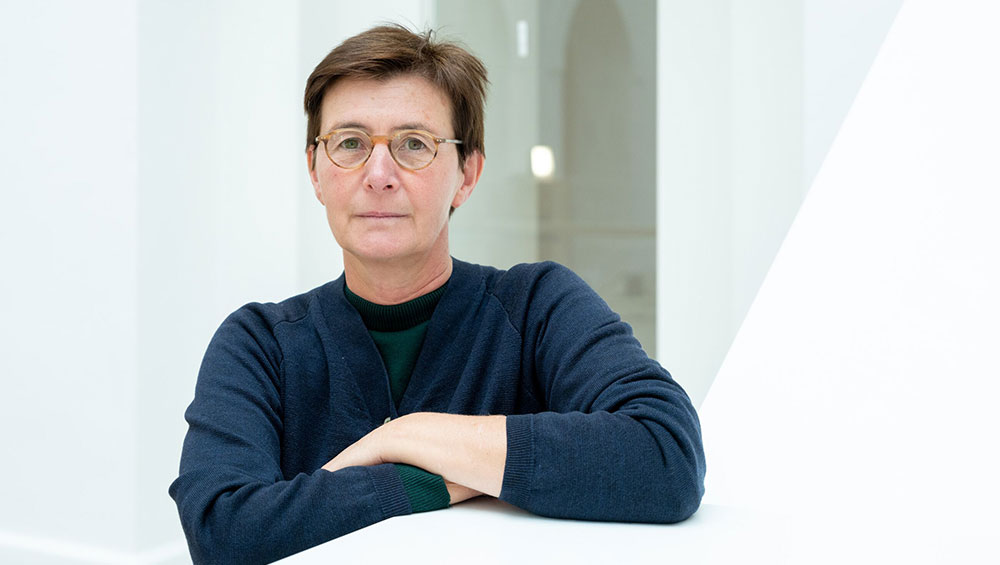
Berlinde De Bruyckere. © Berlinde De Bruyckere. Courtesy of the artist and Hauser & Wirth. Photo: Thomas Dashuber / Diözesanmuseum Freising.
by VERONICA SIMPSON
In Berlinde de Bruyckere’s art there is almost unbearable sorrow, yet there is also profound comfort. Her sculptures, in wax, bronze and wood, often take us to the brink of human or animal suffering, but they also offer relief. There is something about the presence of these works – whether the limbs of blasted trees stretching across a room; the contorted body (reproduced in wax) of a horse, its exterior clad in real horsehide; piles of densely stacked, grey blankets trapped in a cage; or cowled figures, her Arcangeli, standing on their tiptoes on the point of lift off – that speaks to something essential in the human condition. They chart every point on the emotional landscape between hope and despair, and yet they also articulate beauty, compassion and grace.
In the 1990s, her work using found blankets emerged, sourced from secondhand shops, and in her painterly layering of colours, patterns and textures, they exuded their sense of being discarded as well as evoking the people who had used them, loved them, and let them go. In 2000, as only the second artist to take up the residency programme at the peace museum In Flanders Fields, Ypres, she came across archive images of the bombed out streets of Belgium, deserted except for dead horses. That was when she conceived the idea of using casts of dead horses in her work. Interviewed in 2018 by Denmark’s Louisiana channel, she said: “In war, you don’t talk about one single person who died.” Rather, she said, there was enormous loss, which for her could only be represented by the body of a horse, which is huge and strong, but helpless when it is dead. “To start from something real is for me the easiest way to translate it or to transform it into something new.”

Berlinde De Bruyckere, Embalmed Twins II, 2017, Installation view Engelenkeel, Bonnefanten, 2021. Photo: Mirjam Devriendt.
All her work feels bodily, even the dead trees and blankets, so when she works with bodies – rendering flesh through wax, wood or bronze – they are visceral. They have the rawness of a Francis Bacon, without the distortion of rage. Instead, they exude empathy. I learn, after our conversation, that her father was a butcher, which may be why she has stronger nerves than many for studying, and reproducing, the qualities of flesh.
She completed her fine art studies in 1986, at LUCA School of Arts in Ghent, where she still lives and works, and she received an honorary doctorate from the University of Ghent in 2015. She represented Belgium at the Venice Biennale in 2013, having first exhibited there in 2003. She has had solo exhibitions worldwide, including at the Kunstmuseum Bern in 2011; the Australian Centre for Contemporary Arts, Melbourne, in 2012; SMAK, Ghent, in 2014); Kunsthaus Bregenz in 2015; and Sara Hildén Art Museum, Tampere, Finland, in 2018. Her solo installation City of Refuge III was at the Abbazia di San Giorgio Maggiore in Venice in 2024.
Mirjam-Devriendt-hires.jpg)
Berlinde De Bruyckere, Khorós, installation view, BOZAR Centre for Fine Arts, Brussels, 2025. Photo: © Mirjam Devriendt.
Her sculpture Arcangelo IV, 2024-25 is on show in Leuven, a permanent installation to celebrate KU Leuven’s 600th anniversary. She currently has two solo shows, Khorós, at Bozar in Brussel, and Lift Not the Painted Veil, at Ernst Barlach Haus in Hamburg.
Studio International interviewed the artist online, from her home studio.
Veronica Simpson: You said in a filmed interview for your show four years ago at Antwerp’s Middelheim Museum: “If you have an honest approach to life and you soak up things that happen around you like a sponge, at some point those things have to come out. They have to take shape, become a sculpture.” So how do you manage the dialogue between what you are seeing in the world around you and your response to it?
Berlinde de Bruyckere: It starts always from what I see around me, what I read in the newspapers every morning, and what I see on the half-hour walk from my house to the studio. I walk from the city centre to a neighbourhood near the harbour that is really poor: they have a lot of immigration and people whose lives are difficult. It’s a very good beginning of the day to be aware of the situation where I live these days. And since the beginning, I have always made references in my work to old masters, to themes that they use in their paintings and their sculptures, because, for me, they are ongoing. It’s not that we’re now living in a period when we can do something completely new without any reference to the past and going into the future. After more than 30 years, I feel even more now that strong connection with the past.
People ask if my work is politically correct. I always say I’m not political. Politics is a situation of our days and very often with politics you have to react very quickly, and you don’t have time to reflect. But talking about war and people in danger who have to leave their country, they are on the road, this has been going on since mankind’s first days.
VS: What your sculpture also speaks of, to me, is the sense that we must pay attention to what is happening around us in the world, and to each other. Especially your Arcangeli, which I saw in Venice last year.
BdB: What you saw in Venice is really my reaction to that, looking to the angels in the church. They are not the angels that people know, coming from beautiful paintings and sculptures. They are very mystical creatures. They are beyond an angel for me. They can keep your secrets. You can talk to them, but they have this veil, made from wax and skin. It’s strong, it’s very heavy; that can be a very good container for our souls and our thoughts.
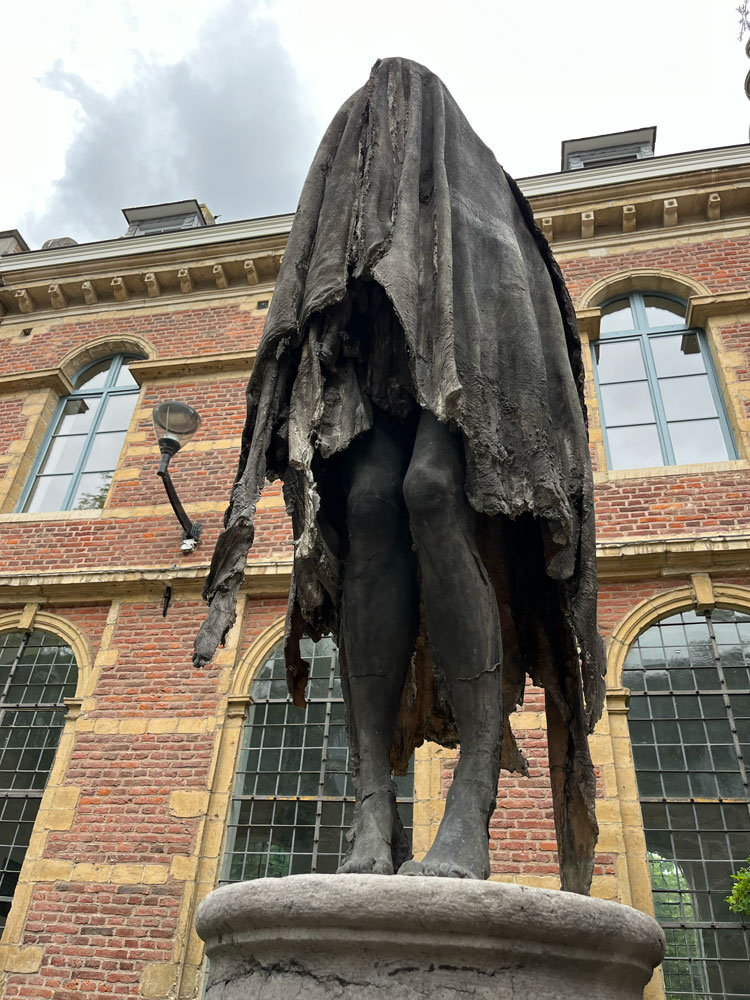
Berlinde De Bruyckere, Arcangelo IV, 2024-25 (2025), installation view, KU Leuven, Belgium. Photo: Veronica Simpson.
VS: I encountered another Arcangelo recently in Leuven, as part of the 600th birthday celebration of the university. I noticed that this angel is on its tiptoes. We don’t know if your angels are on the point of departure or just landing. There’s an incredible presence to these sculptures, balanced between hope and despair. Is that balance something you have to calibrate as you are making the work?
BdB: When I put myself in the position of that angel, they travel somewhere (here) and they don’t know where they are going to. And when they arrive, humans start talking to them and they must be very confused. And when they’re ready to go, the angels are filled with our thoughts and our feelings and secrets that they take with them to another place that we don’t know. This is what plays in my head when I start to think about the angel’s position, and for that, to be on their toes is really important.
VS: This one in Leuven looked particularly heavily burdened.
BdB: When I was working on the angel for Leuven, I felt I was putting more and more material on top of it. In the bag, there was this extra piece of skin (horse hide) that looks like a wing. It was the only one that had shape. So, I loaded it up with more and more. That’s why he looks heavy. Also, because the situation is growing worse and worse – that gives me the power to think about this and to put something extra on that angel. The material and the colour, it’s rather dark, it’s not a shiny golden angel. When I was working on that angel I was also working on my exhibition in Bozar. I took the train from Ghent every day. I saw lots of people sleeping in the station in winter, with lots of blankets and mattresses. And the people were covered in material, they became like monuments.
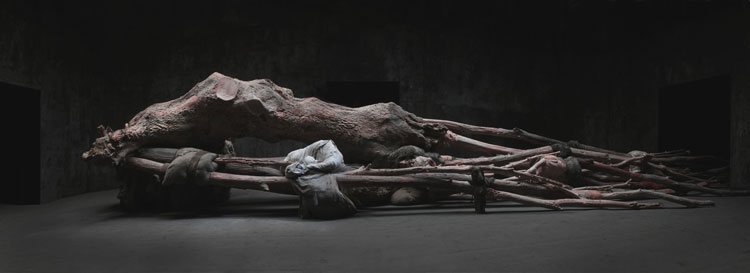
Berlinde De Bruyckere, Kreupelhout – Cripplewood, 2012–13. Belgian Pavilion, Venice Biennale, 2013. Photo: © Mirjam Devriendt.
VS: There is another quality that your sculptures, especially the Arcangeli and the blankets, speak of. They ask: “What are the qualities of care that we see in the world around us; the good and the bad?”
BdB: The first time I was really working around the theme of care was in the Belgian Pavilion in 2013. We had a huge tree as a big, wounded body, that had first aid done not by nurses but by my assistants. I was looking to them as nurses doing first aid on this huge body of Saint Sebastian. The work was installed in a very dark pavilion. The beautiful, light, bright Belgian pavilion I transformed into a dark one, with holes in the ceiling and everything was painted in black. For me, this was a reference to the plague, the Black Death in Venice, when lots of people were dying. The idea of using this black in Venice was also because of the care of Venice, the city. When I was walking in the streets, I saw water reaching higher up these walls, and the feeling that we have to take care of this, otherwise Venice will no longer exist. The care of the body of Saint Sebastian, the care of the body of the dead tree, the care of the city – it’s all these cares together. Care is part of how I look at the world. We have to be careful and not just consume.
VS: There is something very bold about the darkness in that pavilion. Also, the bleak quality of the shrouds around the Arcangeli, and their bruised and dirty limbs. Your skill at drawing us closer to that darkness is finely judged, and made possible by a quality of compassion and hope. Are you a spiritual person? Do you have a spiritual practice?
BdB: No.
VS: Do you meditate?
BdB: I think I meditate when I work. The creative process takes a lot of time. The technique starts with moulding, with physical work, because you choose the tree, you choose the body, you do the moulding, it takes time. Then you start to learn what it is. I make just one copy: if I do a cast on a tree in a mould, I first cast the reality, just to learn from that. Then I start to redo. To think about the colours that I will use for that work, what I want to say with that work, and how I can start to do deformations or make different combinations of one part of that tree with another part of another tree to make sure this is the work that I want to make. All these things need a lot of time. And the process of painting is something I do on my own. In that period, I don’t have any assistants. And this is really zen. And, meanwhile, I’m thinking or meditating on the work. Sometimes I’m in one mood, sometimes I’m in another. And you really can feel in the end the mood I want to express.
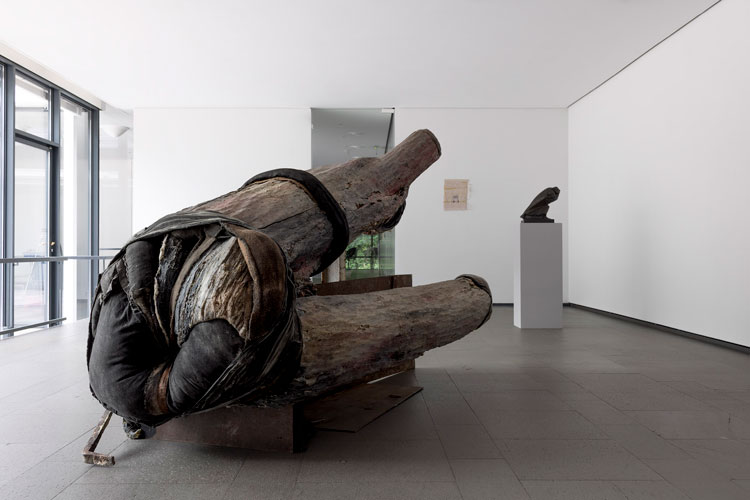
Installation view, Berlinde De Bruyckere. Lift Not the Painted Veil, Ernst Barlach Haus, Hamburg, 2025.
For example, recently I was in Hamburg, in Ernst Barlach Haus, where I opened a solo exhibition for which I made one new work. It’s a figure. It started from a naked figure that I made in wax, that I covered with horse skin but with the inside of the skin rather than the hair side facing outwards, so it feels more like leather than skin. It follows the shape and movement of the body. Everything is covered. When I was working on that sculpture, my assistant said: “This is really a dead body. There is no hope in it any more.” And I realised: yes, that was my intention – for the first time, really to work on death in my work. I have a lot of death in my work, but there is always something hopeful or something that brings you back in the past or gives you memories of life. But this time it’s ominous. You don’t see if it’s a woman or man, just the body. And it’s lifeless.
It’s important to understand why I was making this work. The first reason was that I studied (the German expressionist, Ernst Heinrich) Barlach. He was a wood carver, also making sculptures in bronze, very active in the early 1900s. And he worked during the war, with teams of refugees, people in danger. He sculpted angels, and a lot of themes in his works I recognise in my own works, and it gives me the power to continue. With Barlach’s work, I feel his figures are always in a sort of prison, with plinths of heavy wood. The heaviness of the wood and the plinth means these figures can never lift, they don’t have any elegance.
The starting point of working around this piece was something I have had in mind for some years: to make a polychrome sculpture. When I visited The Sacred Made Real at the National gallery in London (2009), I was jealous of their technique. All the ways in which they explored making these beautiful wooden sculptures feel so real, because of how they have been painted. Since then, I have been looking to find a painting technique that I could use in my own work.
Another reason for what I have made for Hamburg is from what we see on the news, all those white bags, the bodies of people in Gaza with their children and their sons. We are living in a very heavy time, and we don’t know how it will go. It’s a natural response.
VS: That sounds really powerful. An important gesture in these times. I would like to explore your investigation of the plinth as another sculptural form, which you mentioned in an interview about the San Giorgio Maggiore installation.
BdB: I was already working on the theme of the Arcangeli before Venice. I started during the pandemic and then I was invited to do this project in Venice. It feels the right thing to bring something related to the church, not just to bring my sculptures into the church but really work with the church. The beautiful architecture of Palladio helps but, on the other hand, it’s a big thing to react to that and put your own work in this beautiful church. So, I studied the church, with all the elements you have there – the architecture, the columns, the windows, how the light was turning during the day, the colour of the walls, the paintings that are there. We started to make a scale model in the studio of the church, and then we started to put the angels in their positions, with a lot of respect for the old masters that you can see behind. Because of this, I didn’t put my work under the cupola – this is what most artists do, which is like giving a new prophecy, or (presenting) answers. And that’s not the right time to give answers, it’s the time to ask questions.
I was working with the curator there, Carmelo Grasso. They have a beautiful archive of all the special textiles they hang around the columns for Easter, for Christmas, for special services. The love and dedication with which they were made was really inspiring. I decided to use this idea of the banner, and I put it behind the angel, thinking how much angel do we need for such a big church? The production time was short, not even one year.
Then I was thinking of the mirror, the effect of the mirror. We brought a big mirror into the studio and put it behind the angel. That gives you another way of looking. You see the architecture reflected in the mirror, but also the back of the sculpture and sometimes you even see the other angels connected in the mirror.
I didn’t want to have a classical plinth, but was looking to make a plinth as also a sculpture. When we installed the plinths without the angels, for me that was also something. They’re really beautiful on their own. We made the angels in the studio to scale. We didn’t have so many big materials available – just wood and beams and metal plates. We built a structure to see how large it needed to be. During this process, we thought: this is not bad. It feels organic and living. So, let’s go in this direction.
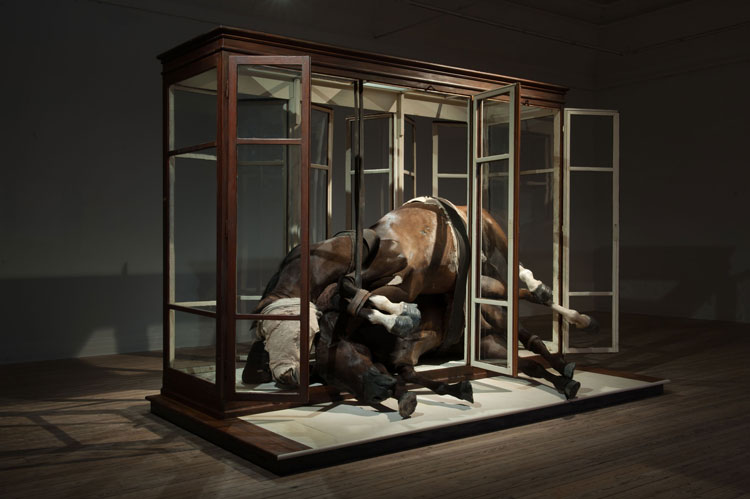
Berlinde De Bruyckere, No Life Lost II, 2015. Bonnefanten, Maastricht, 2021. Photo: Mirjam Devriendt.
VS: I like the idea of collaging provisional elements to support the angels, in the same way that we support ourselves as best we can from the resources around us. You said that you were excited about bringing abstract shapes into your work. Have you explored that further?
BdB: It was something I did before. In 2010, I stopped working with human bodies. I think I did one sculpture where the figure was part of it. But I was done with figuration. My work after that was going into abstraction – though not really into abstraction because I always start from reality and icons. But then there is a group of works, made for It Almost Seemed a Lily (2018-19, at Museum Hof van Busleyden). I did these huge wooden frames (like altarpiece cabinets) and inside there was old wallpaper and on top of it there were layers (of fabric) that resemble a flower. When people are in front of this, they can hardly see the flower. This type of abstraction is my type of abstraction. It’s a way of talking about flowers, about sensuality, and the many layers within that. But then during the pandemic I started using the angel as a motif. I went back to figuration, but not in the same way, casting from live models. I started to reuse my very old moulds, from before 2010, and to enlarge them. I cast the legs in wax and then we made a larger version, because for the angels of San Giorgio Maggiore, the life size was not big enough for that scale of the church. The figures are 2 metres 30cm or 2 meters 40cm.
VS: They are not so big that they are overpowering, but they feel like a protective energy.
BdB: Now one of these angels is in Bozar (her solo show, in Brussels). It’s a long time since I have had an exhibition in Belgium, not since 2014. Many people didn’t see the work in Venice. So, it was important for me to have at least one angel there.
VS: You have brought other works into the gallery to dialogue with yours. Lucas Cranach has been an inspiration for you, but Patti Smith was a surprise.
BdB: It was not my choice to go in dialogue. That was the question of Bozar’s director, Zoë Gray. She wanted to make a new group, a new series of exhibitions, starting from conversations. She asked me to do an exhibition, starting in February, which was quite soon after Venice. I told her there was not time to create new work. But with conversations, this is what I do my whole life, making these references to old masters, but also inspired by literature and films, inspired by Pasolini. That’s one of the dialogues too. And then other dialogues I have that I have never shown before are the dialogues with Patti Smith and also with my husband, Peter (Buggenhout).
For me, Patti Smith is such an important person. She’s much more than some writer, singer, performer, she’s a messenger for me. What she brings to her concerts, and the way that she talks to people. And now she is in her 70s, still travelling the world to bring her message to people. These types of concerts are able to unite people. This is something that she can do on a large scale. As an artist you are more limited. You can unite people in a little group, but not on that scale.
VS. Do you play music when you work?
BdB: No. In the studio we make a lot of noise ourselves. We have this wax technique, where you have to heat the wax. And we have this huge system that takes all the bad air away. And when it’s off, it’s so quiet, I don’t want to have anything around me. Listening to music for me is something I do as a choice. It’s not often that I put on the radio, even in the car. I use music for very particular reasons. When I listen, I really listen. And then I’m obsessed and I listen and listen again and learn from that. I don’t use music as background.
Mirjam-Devriendt-hires.jpg)
Berlinde De Bruyckere, City of Refuge III, installation view, Abbazia di San Giorgio Maggiore, Venice, 2024. Photo: © Mirjam Devriendt.
VS: Who do you listen to when you get these obsessions?
BdB: In terms of old masters, Bach and Gesualdo (Carlo Gesualdo da Venosa, 1566-1613). Nick Cave is a huge inspiration. For my City of Refuge (show) the title is a song of his that I started to work with in the whole series of installations. It’s a song I heard in the late 80s, one of the first CDs of his that I bought. And listening to the same song now, so many years later, during a concert in London, a few years ago, this song became so rich. It’s as if you can feel the life he has lived, and all the damage that he suffered. You can feel that in the way he delivers this song. This is something that I recognise in myself also.
VS: Tell me a little bit about Leuven. I heard the curators explaining the dialogues they introduced between departments, science and philosophy and engineering and economics, together with the artists and poets they chose for their programme. How did that work?
BdB: They organised two meetings. There were scientists, from psychology, academics from literature, economics, all around a table and talking about resilience. What does it mean and how they use this attitude resilience in their work. And for me that was quite inspiring.
We talked a lot about what (stories) we want to tell with our work, and what’s the value of art during these days. And I think there was a big understanding. My themes are not easy. You can’t look to my work to become happy. Other artists have this quality and it’s not that this is better or worse. I don’t have anything to say about this. But I can’t do anything else. And from the audience there I got a huge respect saying it’s very brave to continue working in this direction and even going stronger. And we discussed that it’s the only thing that you can do when you are getting older. You know where the limits are. This was one of the questions in the discussions – how far can you go to show your work in public? Audiences for this (sculpture and poetry) festival are not people who go to museums. They are just people who walk their dog. Having a work in the outside, in a city is different. I don’t have that.
VS: This is you first public sculpture? And what has the response been?
BdB: Yes. I was there during the opening days and led a tour with people who were not familiar with my work. I must say, people really feel that sculpture and it’s so nice that it will be there for a very long period. People will see this sculpture in winter and summer and spring.
VS: It’s going to move to a different site. Remind me where it’s moving to?
BdB: For me, it’s the perfect spot for the piece. You approach it from the street. There are stairs going down and at that moment you see a column which was there already. It’s a found object. It’s leftover from a water pump. Nobody noticed it - people were surprised when I pointed it out. It’s surrounded by buildings, all very eclectic – old buildings, new buildings, buildings just renovated. This is the sort of reading I want to give to that angel too. He is from the past; he is from the future. All the different periods in the architecture can be the period where that sculpture has meaning. He couldn’t survive in a park. In a park, you have trees and nature which is so powerful and then the angel becomes just a sculpture in the park. There, it’s the angel, the wall, the university, a living community around it. I like the idea a lot. There’s also the library there. So, it shares space with knowledge, with lectures, the spoken word.
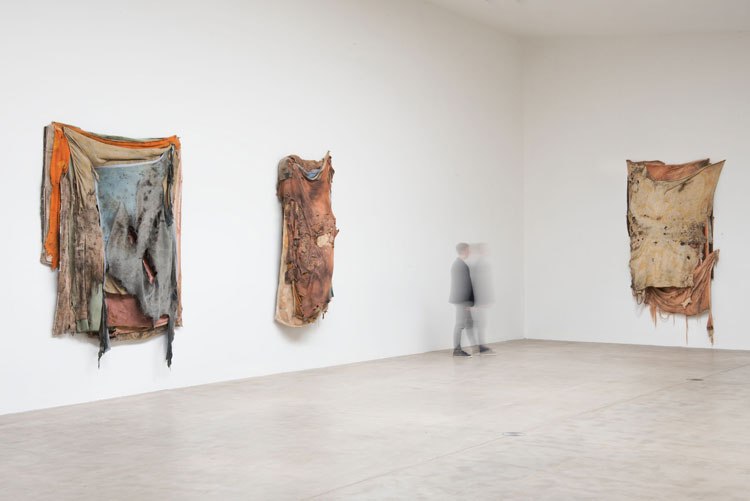
Berlinde De Bruyckere. Stages & Tales, installation view, Hauser & Wirth Somerset, 2018. © Berlinde De Bruyckere. Photo: Mirjam Devriendt.
VS: You have mentioned that your work is not about making people happy. But given it is so infused with this awareness of the balance between tragedy and hope, how do you stop yourself from becoming negatively impacted by this focus?
BdB: How can I start to answer that question (a pause ensues). It’s because of this feeling I mentioned of being a sponge. A sponge is very flexible, it absorbs a lot and then woosh, it’s empty. And everything that is leaking is what I make. And, yes, sometimes the sponge is filled very quickly, and it’s there for a while before I can process. And this is the period where I have a lot of ideas. I make drawings, I might try out different techniques with new materials. But then the moment when I start to work with this, this is the moment that I become very fragile and I have to protect myself. It’s very demanding working on these topics. And I know how far I can go before I have to put it away for a while to start on something else. But the reason I can do that, I think, is that I grew up in a boarding school, with a lot of loneliness. I learned that I have to take care of myself all the time. I was only five when I went to boarding school. That was the hard part. On the other hand, at the weekend and in the holidays, I was living in nature, with my grandmother and my aunt, and they gave me so much love and understanding and beauty and we worked in the garden, and we were knitting clothes for me. I was next to the farm where I would sometimes work with my friends. This duality between all the love there and the strict, rigid boarding school was also … you couldn’t combine it, but I was able to do it.
VS: Because you had a refuge.
BdB: When I was in the boarding school, that was when I started to make my drawings. Drawing was really my way out, to escape my ugly boarding school with very difficult nuns. But I think that was when the seeds were planted that made me become an artist. I have no bad feelings about that time, and I think it’s because of this situation that I’m an artist. And that I’m able to do what I do right now.
• Berlinde de Bruyckere: Khorós is at Bozar, Brussels, until 31 August 2025, and Lift Not the Painted Veil, at Ernst Barlach Haus in Hamburg, until 2 November 2025.
Click on the pictures below to enlarge